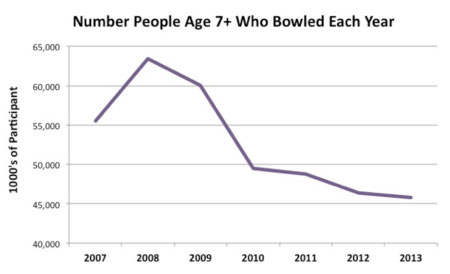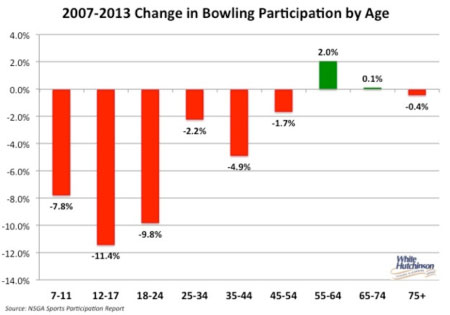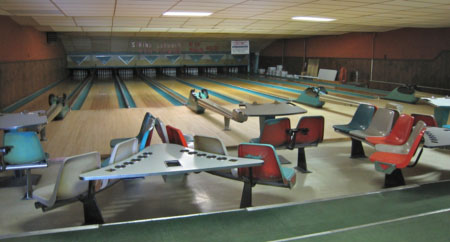
Vol. XIV, No. 6, July 2014
- Editor's corner
- Let's all go out and SHOUT!!!
- Foundations LITE - August 19, Atlanta GA
- Failure or success?
- The 6 types of wine drinkers
- Future proofing projects
- Bowling, an industry in two different centuries
- A frozen dairy nation
- Cultural changes to leisure time and its impact on LBEs
- Canada's anti-spam law
Bowling, an industry in two different centuries
It's not a pretty picture. The number of American's that go bowling each year is in a steep decline.

Although it might appear that the Great Recession that started in the end of 2007 is the cause of the decline, we are able to track the start of the decline in bowling participation back to 2006. And in reality, the decline is really more severe than the graph shows, as the population has been growing over the years, so the per capita participation rate has dropped more even drastically.

What's happening? Is bowling on its deathbed? The answer is both yes and no.
First for the yes part. Bowling leagues are on their deathbed. It used to be that leagues generated close to three-quarters of a bowling alley's business. Think about it, not all that many years ago, back in the 20th Century, people would sign up to show up in a bowling alley at a fixed time every week for up to 32 years. Imagine that happening today. Heck, it is hard enough to get people to commit to something next week. Bowling in a sense used to be a blue-collar country club. Blue-collar jobs have been on the decline since then, and the blue-collar workers still around demand more flexibility to their future leisure time commitments.
So that is a significant part of the cause in the decline; leagues have declined to about 20% of the business and their trend is continuing downward. The other part of the cause of the decline is all the old bowling alleys. Most are in terrible condition. They do not meet modern décor, atmosphere, maintenance, guest service/hospitality and food quality expectations. They are not a place where a more upper-socioeconomic casual bowler wants to frequent. Most bowling alleys are 20th Century old-aged dinosaurs trying to operate in the changed leisure competitive landscape of the 21st Century, and as result they are on a rapid decline in numbers as they have lost their customer base.
However, there is a bright side to the picture. A new type of 21st Century venue with bowling has emerged to attract the American public. We don't call them bowling alleys. In fact, bowling is just one component of many. They offer more than bowling, often laser tag and sometimes bocce ball and different types of games, including game rooms. They offer food and beverages that meet contemporary standards. They have upscale décor, atmosphere and guest services. The most successful ones offer destination dining in a distinctive restaurant atmosphere. The most successful ones target an upscale adult market and don't water down that appeal with family attractions. The well conceived ones are generating annual revenues north of $6.0 million.
Our company recently conducted market research for two different new bowling centers to cater to the upscale adult market. In one market we found five existing bowling alleys, none of which any one who had any higher standards would want to be caught dead in. In fact one of those centers hadn't been even remodeled for close to 40 years, still had the old settee seating and didn't even have automatic scoring. Unless there is a smartphone app for keeping score, a contemporary casual bowler couldn't even keep their score there.

It's hard to believe you can still find antique bowling alleys like this. Anyone have an app to figure out how to keep score?
In the other market we found four terrible old bowling alleys and only one that had been built in the last ten years that we would give a B- grade to.
It's no wonder the number of bowlers is on the decline. In most markets there isn't a decent place to bowl. And in those markets that have the new upscale bowling-restaurant centers, the business in those centers is thriving.
The sooner the old 20th Century dinosaur alleys die off, the better it will be for bowling; as then the industry as a whole can regain a reputation as a leisure option that meets the contemporary consumer's entertainment and dining expectations.
Vol. XIV, No. 6, July 2014
- Editor's corner
- Let's all go out and SHOUT!!!
- Foundations LITE - August 19, Atlanta GA
- Failure or success?
- The 6 types of wine drinkers
- Future proofing projects
- Bowling, an industry in two different centuries
- A frozen dairy nation
- Cultural changes to leisure time and its impact on LBEs
- Canada's anti-spam law


